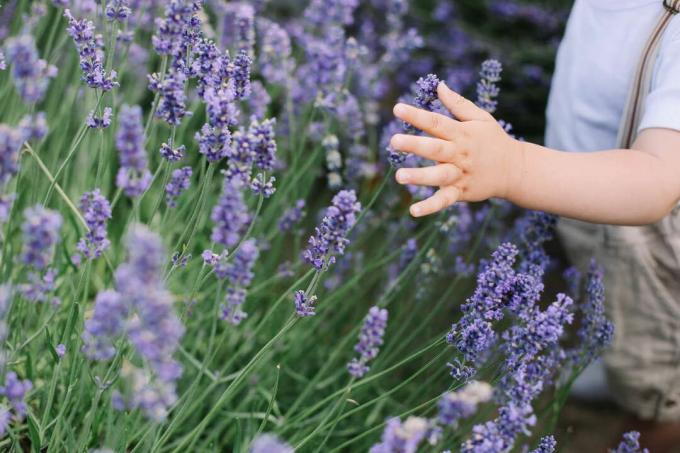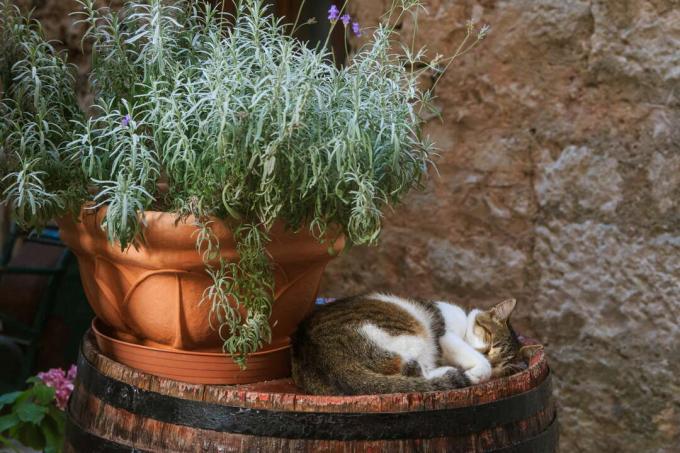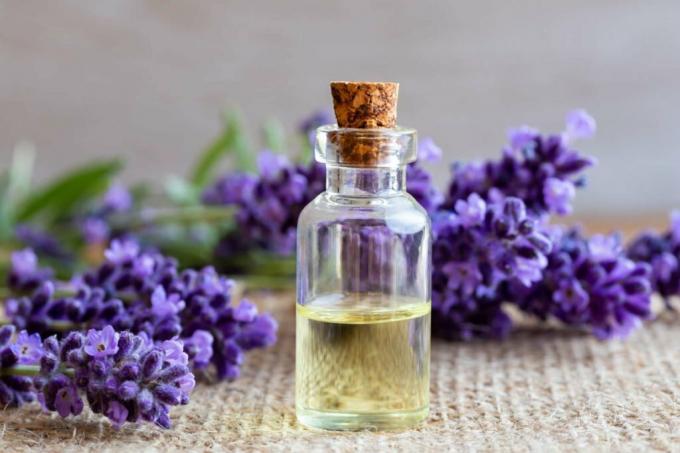Many people are concerned with the question of whether the intensively scented lavender is edible or poisonous to cats, dogs or humans. We clarify.

lavender (Lavandula) is a wonderfully smelling herb with a wide range of uses. And many hobby gardeners would certainly like to have their own lavender bush for the garden or balcony. Usually, however, concerns quickly arise as to whether lavender might not be poisonous to children and animals. After all, it can sometimes happen that the plants are nibbled on when you are not being observed.
contents
- Is Lavender Toxic to Adults and Children?
-
Is lavender poisonous to cats, dogs and co?
- Lavender poisonous to cats
-
Edible lavender: use in the kitchen
- Dry lavender yourself
- Lavender as a remedy: ingredients and active ingredients in lavender
It should therefore be anticipated that it naturally makes a difference whether the lavender leaves and flowers or concentrated lavender oil are taken. In addition, there are also differences in the different types of lavender.
French lavender (Lavandula stoechas) and spike lavender (Lavandula latifolia) contain, for example, very high concentrations of essential oils. The milder real lavender (Lavandula angustifolia) mostly better.Is Lavender Toxic to Adults and Children?
Lavender plants themselves are not poisonous to children and can therefore be integrated into the family garden without much concern. Nothing happens if the little ones put individual plant parts in their mouths. The scent of a sleeping herbal pillow filled with dried lavender blossoms can even work wonders for fussy babies.
Caution is advised when using lavender oil. Children under the age of two should generally not be treated with essential oils of any kind. Lavender oil must not be inhaled by small children, applied to the skin or used to scent the cot. In the worst case, this can even cause the child to stop breathing. Older children don't have a problem with the high concentrations of essential oil, but should use significantly lower dosages than adults.

Lavender essential oil is obtained by steam distillation. It is one of the few essential oils that can be applied directly to the skin. Of course, every person reacts differently and skin irritation and rashes can sometimes occur. Due to the slightly corrosive effect, mucous membranes should not come into contact with the lavender oil at all. Adults should only take small amounts of real lavender oil internally, because too high a dose can cause irritation of the stomach. Spike and French lavender oil can even be toxic in high doses.
Sensitive people react with a headache when lavender oil is burned off in an aroma lamp. If hypersensitivity to lavender is known, the use of lavender in any form should be avoided. Although there are a large number of products with lavender oil on the market for pregnant and breastfeeding women, whether the external application causes side effects has not yet been conclusively determined checked. However, the use of tufted lavender or spike lavender is not recommended at all during this time. In general, we advise you: In the case of illnesses and serious complaints - regardless of whether you are suffering from one Count risk group or not - you should definitely check the use of lavender with a doctor arrange.
Is lavender poisonous to cats, dogs and co?
There is a widespread belief that the wonderfully fragrant lavender bushes are poisonous to pets. All parts of the lavender plant are harmless, at least for cats and dogs. If your darlings nibble on it from time to time, there is no risk of poisoning. In contrast, rabbits and guinea pigs can very well suffer from lavender poisoning. The same applies to other small rodents such as mice and hamsters. They cannot tolerate the high concentrations of essential oils and, in the worst case, can even die from it.
Lavender poisonous to cats
For cat lovers, lavender is one of the harmless plants for the balcony and garden. However, it should not be consumed regularly by our four-legged friends due to the essential oils it contains. Many cats instinctively avoid lavender anyway - not because it is poisonous for them, but because the velvet paws can't stand the strong smell of the plant.

Animals are very sensitive to smells. Therefore, only use fragrance lamps with essential lavender oil indoors with caution. As a cat owner, you should also give your pet the opportunity to leave the room to avoid the strong scent of lavender. The internal use of lavender oil in restless cats is not recommended at all.
Edible lavender: use in the kitchen
Lavender is generally edible in small amounts. In the kitchen, however, you should only use real lavender. Due to its intense taste, lavender usually only plays an accompanying role as a spice anyway. In the worst case, larger amounts can lead to stomach and intestinal problems. Children, pregnant and breastfeeding women should ideally not consume lavender, or only in very small amounts. Due to their ingredients, crested lavender and spike lavender are only used by very experienced cooks and then only in extremely small quantities as a herb in the kitchen.
Dry lavender yourself
In order to have some of the fragrant flowers longer, you can dry the flowers of real lavender. Harvest time is during peak flowering from June to August. Cut the branches about 10 cm below the base of the flower and spread them out on a cloth. After a few days you can then hang up the lavender in bunches. Finally, after removing the stems, you can store the purple flowers in jars or cans in the dark. This preserves the color and aroma over a longer period of time. More information about Drying of lavender can also be found in our special article.

Lavender as a remedy: ingredients and active ingredients in lavender
In addition to tannins and other secondary plant substances, lavender contains a high proportion of essential oils. However, the composition of lavender oil is extremely complex. The main components linalool and linalyl acetate together make up about 75%. But other components – such as cineol, borneol and camphor – also make an important contribution to the overall aroma.
The essential oil has a disinfecting effect and is therefore often used in natural cosmetics. When making homemade creams and body oils, however, you should not overdo it with the amount of lavender essential oil. Carefully approach the right amount, because a few drops are usually sufficient.
For home use, you can make an oil extract from the lavender flowers. For this you should put the parts of the plant in a glass and completely cover them with native vegetable oil - such as olive oil. After about two weeks, the homemade lavender oil is ready and can be strained. You can use it, for example, to heal burns and minor injuries. But you can also use it as a massage oil for tense muscles or apply to bare parts of the body in summer to keep mosquitoes away.

In exciting times, the scent of lavender brings calm and balance to many people. Filled with scented sachets, the dried flowers help you fall asleep. At the same time, the herb also has a mood-enhancing effect. Lavender is a classic nerve relaxant that has a relaxing effect without making us tired. The Mediterranean herb can also provide relaxation for headaches. In addition to using the (essential) lavender oil, you can also drink the dried flowers as a tea or add them to the bath water.
The variety of Types and varieties of lavender is almost overwhelming. We have compiled some of the most popular ones for you.

